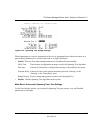
700 Series Managed Switch User’s Guide for Software v2.1
4-24 Administration Console Telnet Interface
SM-10004-02
Table 4-1. STP Port Setting Parameters
Figure 4-33: Spanning Tree: Port Settings
Fastlink in STP mode. If a client is trying to access a server through the switch running the STP
negotiation, it will not be able to connect to it immediately. This can be a problem for some
networks. Fastlink mode solves this problem by setting the port to direct forwarding mode, thus
allowing any server access request to be forwarded. Fastlink mode can cause temporary loops in
your network, but STP will find and eliminate them. Fastlink is best used on end node ports, i.e.
ports connected to PCs or servers, and not on uplink ports to other switches.
Main Menu> Advanced> MAC Address Manager
Static Address and Address Aging can be configured here.
PARAMETERS RANGE DESCRIPTION
Prty (Priority) 0-255 STP uses this to determine which path (which port) to use for
forwarding. The port with the lowest number has the highest priority.
Cost 1-65535 The switch uses this to determine which port is the forwarding port
when the priority is equal. All other factors equal, the path with the
lowest cost to the root bridge will be the active path. The estimated
path cost is the industry standard for the port speed. The default path
cost is the maximum speed for the port.
Fastlink Enabled or
Disabled
When a Fastlink enabled port running standard STP is
connected, it will go through the STP negotiation (listening ->
learning -> forwarding or blocking) before it will be fully
available.


















